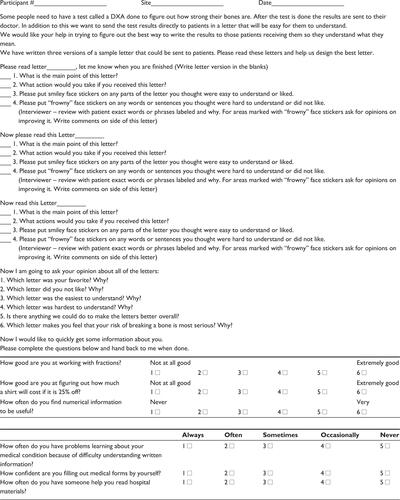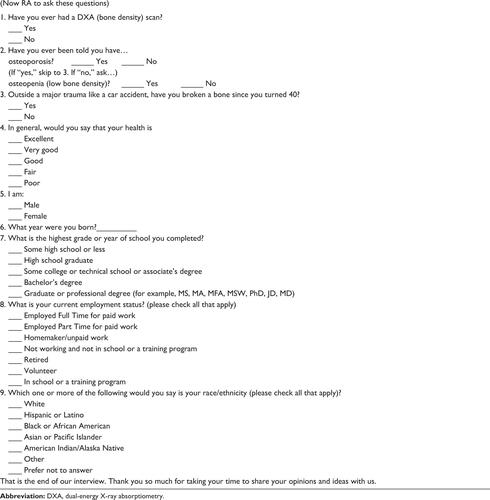Abstract
Purpose
To use a mixed-methods approach to develop a letter that can be used to notify patients of their bone mineral density (BMD) results by mail that may activate patients in their bone-related health care.
Patients and methods
A multidisciplinary team developed three versions of a letter for reporting BMD results to patients. Trained interviewers presented these letters in a random order to a convenience sample of adults, aged 50 years and older, at two different health care systems. We conducted structured interviews to examine the respondents’ preferences and comprehension among the various letters.
Results
A total of 142 participants completed the interview. A majority of the participants were female (64.1%) and white (76.1%). A plurality of the participants identified a specific version of the three letters as both their preferred version (45.2%; P<0.001) and as the easiest to understand (44.6%; P<0.01). A majority of participants preferred that the letters include specific next steps for improving their bone health.
Conclusion
Using a mixed-methods approach, we were able to develop and optimize a printed letter for communicating a complex test result (BMD) to patients. Our results may offer guidance to clinicians, administrators, and researchers who are looking for guidance on how to communicate complex health information to patients in writing.
Acknowledgments
The authors would like to thank Shelly Campo and Natoshia Askelson for their expert advice on the design of the letters. We would also like to thank Brandi Robinson, Mollie Giller, Rebecca Burmeister, Sylvie Hall, Roslin Nelson, and Akeba Mitchell for their assistance in data collection and coding. This study is a pilot trial as part of the PAADRN study that is registered at clinicaltrials.gov (Trial NCT01507662). Dr Solimeo received partial support from the Department of Veterans Affairs, Center for Comprehensive Access & Delivery Research and Evaluation, Iowa City VA Health Care System, Iowa City, IA. Dr Cram is supported by a K24 award from the National Institute of Arthritis and Musculoskeletal and Skin Diseases (AR062133). This work is also funded by R01 AG033035 from the National Institute on Aging at the US National Institutes of Health. The US Department of Health and Human Services, National Institutes of Health’s National Institute on Aging had no role in the analysis or interpretation of data or the decision to report these data in a peer-reviewed journal.
Disclosure
The views expressed in this article are those of the authors and do not necessarily reflect the position or policy of the Department of Veterans Affairs or the United States government. The authors report no conflicts of interest in this work.


